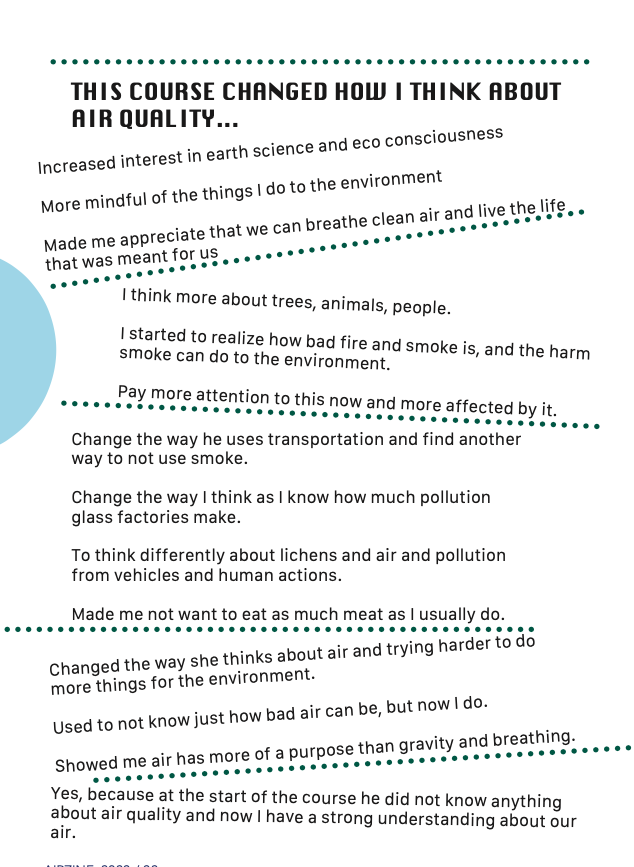Case Studies: Community Impact
What Is In Your Air? Youth Air Quality Curriculum








PORTLAND, OR + WOLF CREEK, OR
PROBLEM
Disadvantaged youth populations are not directly informed on air quality matters. They are at-risk for health impacts from poor air quality and typically do not have a seat at the table to discuss air impacts.
ACTION
I was solely accountable for program management and grant-related responsibilities. I also co-designed a hands-on, year long air quality curriculum aligned with STEM and Oregon educational standards. Students engaged in weekly activities making air quality relatable and fun ranging from presentations with experts, conducting their own citizen science at school and out in the field, and the creation of their own magazine.
IMPACT
This program cultivated and empowered youth activism on air quality issues through direct engagement in the custom air quality curriculum. This multi-agency collaboration highlighted why air quality matters leveraging decades of research at the state and national level custom tailored to reach underserved youth.
CREATIVE OUTPUTS
The images highlight student engagement with the program and fieldwork. See student work and empowerment statements in their magazine.
The reality is that underserved communities can be disconnected from public lands, and are often disproportionately exposed to higher levels of air pollution. To empower youth in these communities through first hand experiences, in their community, is powerful. Learning about impacts to their air could create opportunities for change. This work is necessary now more than ever, especially with increased wildfires, urbanization, habitat loss, and declining biodiversity.
Created with Project team: Karen Dillman, Ron Donoho, Linda Geiser, Sarah Gray, Shawn Hardy, Jody Hoffman, Adrienne Kovasi, Morgan Schafer, Hillarie Sales, Lichens CitiSci, the Oregon Department of Environmental Quality, Sunny Wolf Charter School, and USDA USFS National Air Resource Management Program.
Check out a blog from the Oregon Department of Environmental Quality on the project.
National Environmental Education Foundation
Lichens CitiSci
Oregon Department of Environmental Quality
Sunny Wolf Charter School
USDA USFS Air Resource Management Program

Regional Impact Strategies for Non-profit Professional Development Board + Membership






LOS ANGELES, CA
PROBLEM
A 45 year old professional development organization that cultivated and empowered museum professionals needed operational overhaul to revive and modernize to better meet needs of declining membership.
ACTION
I led a strategic review of the organization’s operational management to reinvent the structure, expanding the Board of Directors by creating specific positions reflective of organization needs. This also included a brand refresh and a new framework for digital and in-person engagement tactics to reflect the evolving organization.
IMPACT
New organizational structure promoted distributed accountability to better support museum professionals across Southern California, and increased impact within the field at-large. Brand revisions and engagement tactics created more relevant connections with up and coming professions, aiding in doubling our membership leading to increased programing and community support and resources.
CREATIVE OUTPUTS
These images show the new branding and outreach materials for increased programming and content channels. Not pictured are many documents and spreadsheets.
Museum Educators of Southern California
Scientific Engagement Tactics to Reach International Audience




LOS ANGELES, CA + ALBUQUERQUE, NM
PROBLEM
The largest urban fossil site in the world has been engaging non-experts in scientific content for over 100 years, but not many people knew the details on these strategies and tactics.
ACTION
I was the lead researcher and presenter on a poster highlighting the strategic engagement initiatives that the museum had used over many decades. I focused on the continued display of the live paleontological process as foundation in my work. My organizational strategy and aggregation of historical knowledge became an archival treasure trove for the future.
IMPACT
In a time of rapid global change, it is critical to engage the public in earth and biological sciences - both by imparting scientific facts on earth systems, ecological change, and extinction, and by sharing the practice of data collection and hypothesis testing, instilling confidence in the scientific process. This direct engagement with the scientific process allows La Brea Tar Pits visitors to come away not only with a better understanding of how Earth has changed in the past, but with tools for empowered thinking about how it may change in the future.
My research encouraged efforts for continuous access to paleontological processes as a priority to instill curiosity and wonder about the natural world and the Los Angeles climate story for local and global visitors. It also informed the La Brea Tar Pits Reimagining Sessions with global and local leaders to decide the future of the site.
CREATIVE OUTPUTS
In the images above these are examples of engagement tactics used at La Brea over the past several decades. The image below is my poster used to present these ideas.
La Brea Tar Pits
Society for Vertebrate Paleontology

